Java基础13(IO流)
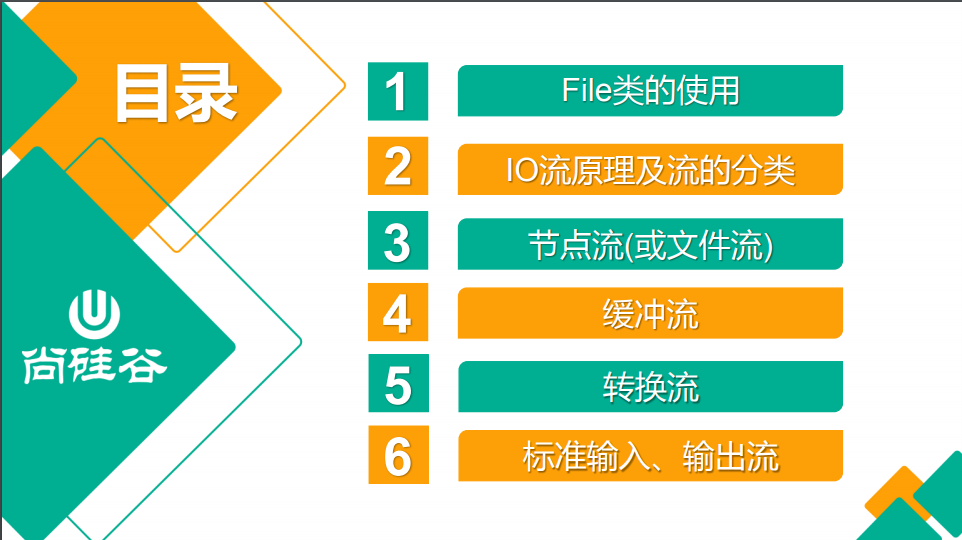
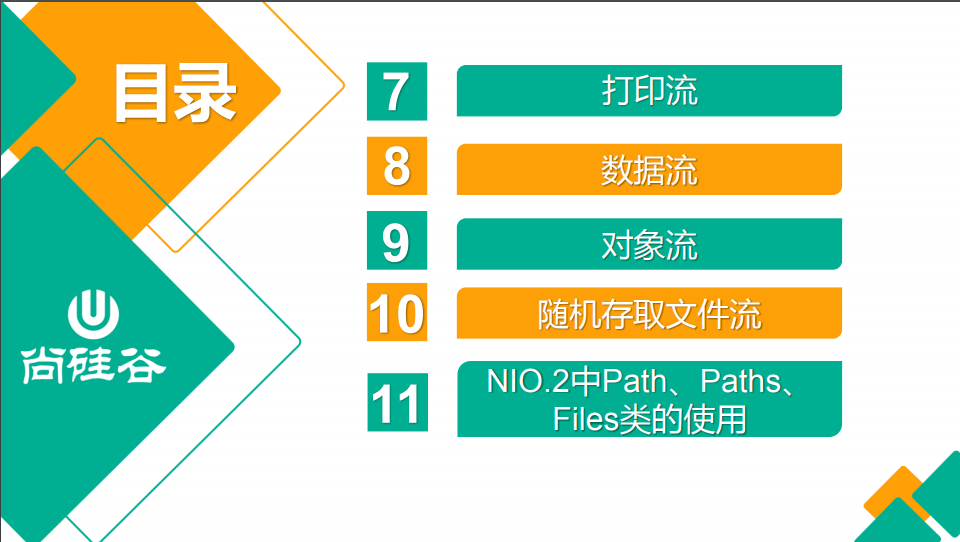

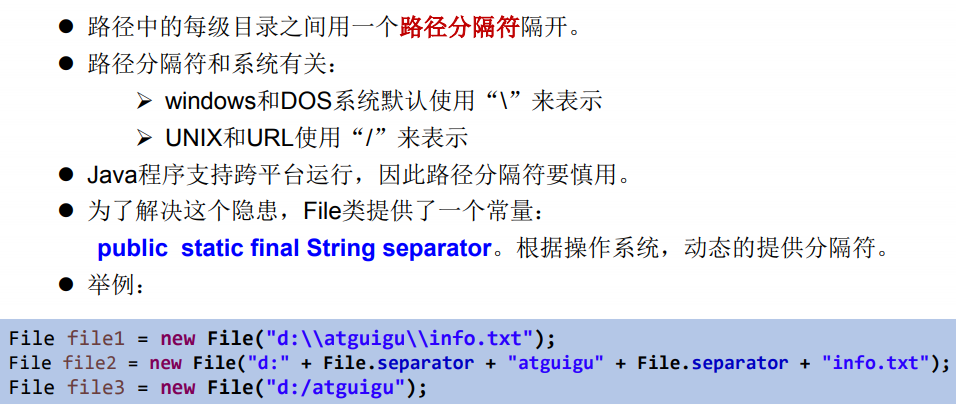

package com.atguigu.java3; import org.junit.Test; import java.io.File; import java.io.IOException; import java.util.Date; /** * File类的使用 * * 1. File类的一个对象,代表一个文件或一个文件目录(俗称:文件夹) * 2. File类声明在java.io包下 * 3. File类中涉及到关于文件或文件目录的创建、删除、重命名、修改时间、文件大小等方法, * 并未涉及到写入或读取文件内容的操作。如果需要读取或写入文件内容,必须使用IO流来完成。 * 4. 后续File类的对象常会作为参数传递到流的构造器中,指明读取或写入的"终点". * * * * * @author shkstart * @create 2019 下午 4:05 */ public class FileTest { /* 1.如何创建File类的实例 File(String filePath) File(String parentPath,String childPath) File(File parentFile,String childPath) 2. 相对路径:相较于某个路径下,指明的路径。 绝对路径:包含盘符在内的文件或文件目录的路径 3.路径分隔符 windows:\\ unix:/ */ @Test public void test1(){ //构造器1 File file1 = new File("hello.txt");//相对于当前module File file2 = new File("D:\\workspace_idea1\\JavaSenior\\day08\\he.txt"); System.out.println(file1); System.out.println(file2); //构造器2: File file3 = new File("D:\\workspace_idea1","JavaSenior"); System.out.println(file3); //构造器3: File file4 = new File(file3,"hi.txt"); System.out.println(file4); } /* public String getAbsolutePath():获取绝对路径 public String getPath() :获取路径 public String getName() :获取名称 public String getParent():获取上层文件目录路径。若无,返回null public long length() :获取文件长度(即:字节数)。不能获取目录的长度。 public long lastModified() :获取最后一次的修改时间,毫秒值 如下的两个方法适用于文件目录: public String[] list() :获取指定目录下的所有文件或者文件目录的名称数组 public File[] listFiles() :获取指定目录下的所有文件或者文件目录的File数组 */ @Test public void test2(){ File file1 = new File("hello.txt"); File file2 = new File("d:\\io\\hi.txt"); System.out.println(file1.getAbsolutePath()); System.out.println(file1.getPath()); System.out.println(file1.getName()); System.out.println(file1.getParent()); System.out.println(file1.length()); System.out.println(new Date(file1.lastModified())); System.out.println(); System.out.println(file2.getAbsolutePath()); System.out.println(file2.getPath()); System.out.println(file2.getName()); System.out.println(file2.getParent()); System.out.println(file2.length()); System.out.println(file2.lastModified()); } @Test public void test3(){ File file = new File("D:\\workspace_idea1\\JavaSenior"); String[] list = file.list(); for(String s : list){ System.out.println(s); } System.out.println(); File[] files = file.listFiles(); for(File f : files){ System.out.println(f); } } /* public boolean renameTo(File dest):把文件重命名为指定的文件路径 比如:file1.renameTo(file2)为例: 要想保证返回true,需要file1在硬盘中是存在的,且file2不能在硬盘中存在。 */ @Test public void test4(){ File file1 = new File("hello.txt"); File file2 = new File("D:\\io\\hi.txt"); boolean renameTo = file2.renameTo(file1); System.out.println(renameTo); } /* public boolean isDirectory():判断是否是文件目录 public boolean isFile() :判断是否是文件 public boolean exists() :判断是否存在 public boolean canRead() :判断是否可读 public boolean canWrite() :判断是否可写 public boolean isHidden() :判断是否隐藏 */ @Test public void test5(){ File file1 = new File("hello.txt"); file1 = new File("hello1.txt"); System.out.println(file1.isDirectory()); System.out.println(file1.isFile()); System.out.println(file1.exists()); System.out.println(file1.canRead()); System.out.println(file1.canWrite()); System.out.println(file1.isHidden()); System.out.println(); File file2 = new File("d:\\io"); file2 = new File("d:\\io1"); System.out.println(file2.isDirectory()); System.out.println(file2.isFile()); System.out.println(file2.exists()); System.out.println(file2.canRead()); System.out.println(file2.canWrite()); System.out.println(file2.isHidden()); } /* 创建硬盘中对应的文件或文件目录 public boolean createNewFile() :创建文件。若文件存在,则不创建,返回false public boolean mkdir() :创建文件目录。如果此文件目录存在,就不创建了。如果此文件目录的上层目录不存在,也不创建。 public boolean mkdirs() :创建文件目录。如果此文件目录存在,就不创建了。如果上层文件目录不存在,一并创建 删除磁盘中的文件或文件目录 public boolean delete():删除文件或者文件夹 删除注意事项:Java中的删除不走回收站。 */ @Test public void test6() throws IOException { File file1 = new File("hi.txt"); if(!file1.exists()){ //文件的创建 file1.createNewFile(); System.out.println("创建成功"); }else{//文件存在 file1.delete(); System.out.println("删除成功"); } } @Test public void test7(){ //文件目录的创建 File file1 = new File("d:\\io\\io1\\io3"); boolean mkdir = file1.mkdir(); if(mkdir){ System.out.println("创建成功1"); } File file2 = new File("d:\\io\\io1\\io4"); boolean mkdir1 = file2.mkdirs(); if(mkdir1){ System.out.println("创建成功2"); } //要想删除成功,io4文件目录下不能有子目录或文件 File file3 = new File("D:\\io\\io1\\io4"); file3 = new File("D:\\io\\io1"); System.out.println(file3.delete()); } }
-----------------练习---------------------
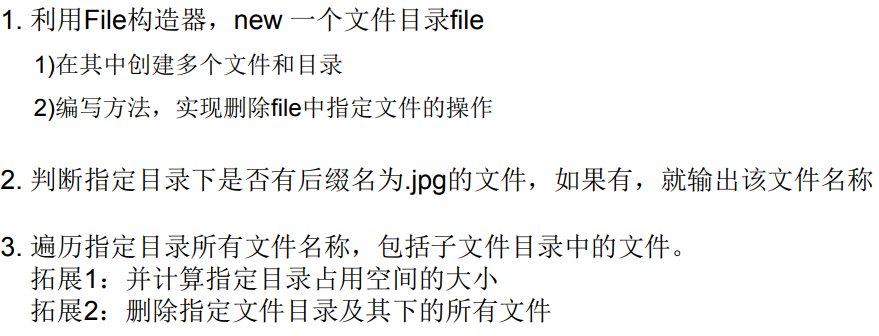

package com.atguigu.exer2; import org.junit.Test; import java.io.File; import java.io.IOException; /** * @author shkstart * @create 2019 下午 4:56 */ public class FileDemo { @Test public void test1() throws IOException { File file = new File("D:\\io\\io1\\hello.txt"); //创建一个与file同目录下的另外一个文件,文件名为:haha.txt File destFile = new File(file.getParent(),"haha.txt"); boolean newFile = destFile.createNewFile(); if(newFile){ System.out.println("创建成功!"); } } }

package com.atguigu.exer2; import org.junit.Test; import java.io.File; import java.io.FilenameFilter; /** * 课后练习2:判断指定目录下是否有后缀名为.jpg的文件,如果有,就输出该文件名称 * @author shkstart 邮箱:shkstart@126.com * @version 创建时间:2019年2月23日 上午1:55:59 * */ public class FindJPGFileTest { @Test public void test1(){ File srcFile = new File("d:\\code"); String[] fileNames = srcFile.list(); for(String fileName : fileNames){ if(fileName.endsWith(".jpg")){ System.out.println(fileName); } } } @Test public void test2(){ File srcFile = new File("d:\\code"); File[] listFiles = srcFile.listFiles(); for(File file : listFiles){ if(file.getName().endsWith(".jpg")){ System.out.println(file.getAbsolutePath()); } } } /* * File类提供了两个文件过滤器方法 * public String[] list(FilenameFilter filter) * public File[] listFiles(FileFilter filter) */ @Test public void test3(){ File srcFile = new File("d:\\code"); File[] subFiles = srcFile.listFiles(new FilenameFilter() { @Override public boolean accept(File dir, String name) { return name.endsWith(".jpg"); } }); for(File file : subFiles){ System.out.println(file.getAbsolutePath()); } } }

package com.atguigu.exer2; import java.io.File; /** * 3. 遍历指定目录所有文件名称,包括子文件目录中的文件。 拓展1:并计算指定目录占用空间的大小 拓展2:删除指定文件目录及其下的所有文件 * @author shkstart 邮箱:shkstart@126.com * @version 创建时间:2019年2月23日 上午1:55:31 * */ public class ListFilesTest { public static void main(String[] args) { // 递归:文件目录 /** 打印出指定目录所有文件名称,包括子文件目录中的文件 */ // 1.创建目录对象 File dir = new File("E:\\teach\\01_javaSE\\_尚硅谷Java编程语言\\3_软件"); // 2.打印目录的子文件 printSubFile(dir); } public static void printSubFile(File dir) { // 打印目录的子文件 File[] subfiles = dir.listFiles(); for (File f : subfiles) { if (f.isDirectory()) {// 文件目录 printSubFile(f); } else {// 文件 System.out.println(f.getAbsolutePath()); } } } // 方式二:循环实现 // 列出file目录的下级内容,仅列出一级的话 // 使用File类的String[] list()比较简单 public void listSubFiles(File file) { if (file.isDirectory()) { String[] all = file.list(); for (String s : all) { System.out.println(s); } } else { System.out.println(file + "是文件!"); } } // 列出file目录的下级,如果它的下级还是目录,接着列出下级的下级,依次类推 // 建议使用File类的File[] listFiles() public void listAllSubFiles(File file) { if (file.isFile()) { System.out.println(file); } else { File[] all = file.listFiles(); // 如果all[i]是文件,直接打印 // 如果all[i]是目录,接着再获取它的下一级 for (File f : all) { listAllSubFiles(f);// 递归调用:自己调用自己就叫递归 } } } // 拓展1:求指定目录所在空间的大小 // 求任意一个目录的总大小 public long getDirectorySize(File file) { // file是文件,那么直接返回file.length() // file是目录,把它的下一级的所有大小加起来就是它的总大小 long size = 0; if (file.isFile()) { size += file.length(); } else { File[] all = file.listFiles();// 获取file的下一级 // 累加all[i]的大小 for (File f : all) { size += getDirectorySize(f);// f的大小; } } return size; } // 拓展2:删除指定的目录 public void deleteDirectory(File file) { // 如果file是文件,直接delete // 如果file是目录,先把它的下一级干掉,然后删除自己 if (file.isDirectory()) { File[] all = file.listFiles(); // 循环删除的是file的下一级 for (File f : all) {// f代表file的每一个下级 deleteDirectory(f); } } // 删除自己 file.delete(); } }
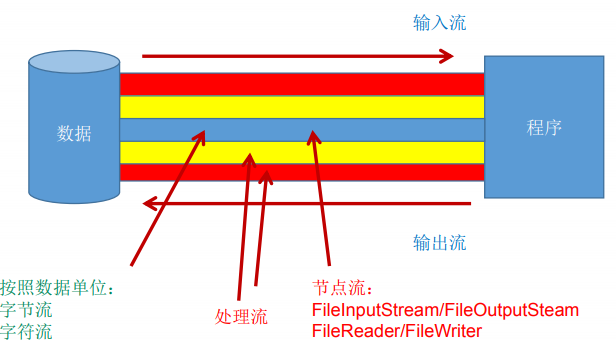
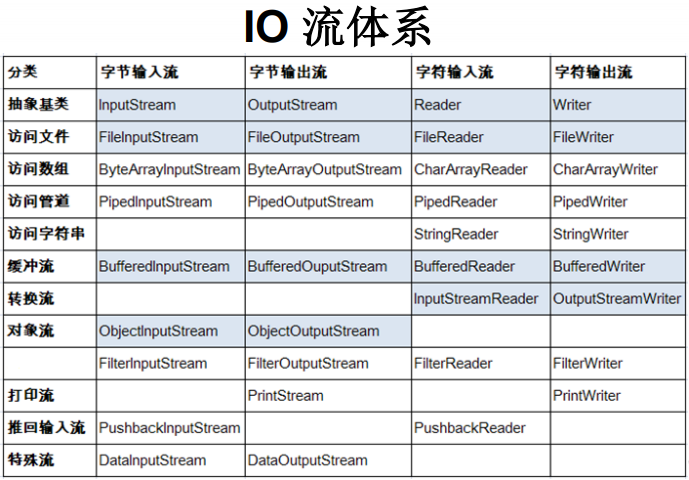
以上不要全部都看,具体看深色的。
学习资料ppt里有更详细的内容。

package com.atguigu.java; import org.junit.Test; import java.io.*; /** * * 一、流的分类: * 1.操作数据单位:字节流、字符流 * 2.数据的流向:输入流、输出流 * 3.流的角色:节点流、处理流 * * 二、流的体系结构 * 抽象基类 节点流(或文件流) 缓冲流(处理流的一种) * InputStream FileInputStream (read(byte[] buffer)) BufferedInputStream (read(byte[] buffer)) * OutputStream FileOutputStream (write(byte[] buffer,0,len) BufferedOutputStream (write(byte[] buffer,0,len) / flush() * Reader FileReader (read(char[] cbuf)) BufferedReader (read(char[] cbuf) / readLine()) * Writer FileWriter (write(char[] cbuf,0,len) BufferedWriter (write(char[] cbuf,0,len) / flush() * * * * @author shkstart * @create 2019 上午 10:40 */ public class FileReaderWriterTest { public static void main(String[] args) { File file = new File("hello.txt");//相较于当前工程 System.out.println(file.getAbsolutePath()); File file1 = new File("day09\\hello.txt"); System.out.println(file1.getAbsolutePath()); } /* 将day09下的hello.txt文件内容读入程序中,并输出到控制台 说明点: 1. read()的理解:返回读入的一个字符。如果达到文件末尾,返回-1 2. 异常的处理:为了保证流资源一定可以执行关闭操作。需要使用try-catch-finally处理 3. 读入的文件一定要存在,否则就会报FileNotFoundException。 */ @Test public void testFileReader(){ FileReader fr = null; try { //1.实例化File类的对象,指明要操作的文件 File file = new File("hello.txt");//相较于当前Module //2.提供具体的流 fr = new FileReader(file); //3.数据的读入 //read():返回读入的一个字符。如果达到文件末尾,返回-1 //方式一: // int data = fr.read(); // while(data != -1){ // System.out.print((char)data); // data = fr.read(); // } //方式二:语法上针对于方式一的修改 int data; while((data = fr.read()) != -1){ System.out.print((char)data); } } catch (IOException e) { e.printStackTrace(); } finally { //4.流的关闭操作 // try { // if(fr != null) // fr.close(); // } catch (IOException e) { // e.printStackTrace(); // } //或 if(fr != null){ try { fr.close(); } catch (IOException e) { e.printStackTrace(); } } } } //对read()操作升级:使用read的重载方法 @Test public void testFileReader1() { FileReader fr = null; try { //1.File类的实例化 File file = new File("hello.txt"); //2.FileReader流的实例化 fr = new FileReader(file); //3.读入的操作 //read(char[] cbuf):返回每次读入cbuf数组中的字符的个数。如果达到文件末尾,返回-1 char[] cbuf = new char[5]; int len; while((len = fr.read(cbuf)) != -1){ //方式一: //错误的写法 // for(int i = 0;i < cbuf.length;i++){ // System.out.print(cbuf[i]); // } //正确的写法 // for(int i = 0;i < len;i++){ // System.out.print(cbuf[i]); // } //方式二: //错误的写法,对应着方式一的错误的写法 // String str = new String(cbuf); // System.out.print(str); //正确的写法 String str = new String(cbuf,0,len); System.out.print(str); } } catch (IOException e) { e.printStackTrace(); } finally { if(fr != null){ //4.资源的关闭 try { fr.close(); } catch (IOException e) { e.printStackTrace(); } } } } /* 从内存中写出数据到硬盘的文件里。 说明: 1. 输出操作,对应的File可以不存在的。并不会报异常 2. File对应的硬盘中的文件如果不存在,在输出的过程中,会自动创建此文件。 File对应的硬盘中的文件如果存在: 如果流使用的构造器是:FileWriter(file,false) / FileWriter(file):对原有文件的覆盖 如果流使用的构造器是:FileWriter(file,true):不会对原有文件覆盖,而是在原有文件基础上追加内容 */ @Test public void testFileWriter() { FileWriter fw = null; try { //1.提供File类的对象,指明写出到的文件 File file = new File("hello1.txt"); //2.提供FileWriter的对象,用于数据的写出 fw = new FileWriter(file,false); //3.写出的操作 fw.write("I have a dream!\n"); fw.write("you need to have a dream!"); } catch (IOException e) { e.printStackTrace(); } finally { //4.流资源的关闭 if(fw != null){ try { fw.close(); } catch (IOException e) { e.printStackTrace(); } } } } @Test public void testFileReaderFileWriter() { FileReader fr = null; FileWriter fw = null; try { //1.创建File类的对象,指明读入和写出的文件 File srcFile = new File("hello.txt"); File destFile = new File("hello2.txt"); //不能使用字符流来处理图片等字节数据 // File srcFile = new File("爱情与友情.jpg"); // File destFile = new File("爱情与友情1.jpg"); //2.创建输入流和输出流的对象 fr = new FileReader(srcFile); fw = new FileWriter(destFile); //3.数据的读入和写出操作 char[] cbuf = new char[5]; int len;//记录每次读入到cbuf数组中的字符的个数 while((len = fr.read(cbuf)) != -1){ //每次写出len个字符 fw.write(cbuf,0,len); } } catch (IOException e) { e.printStackTrace(); } finally { //4.关闭流资源 //方式一: // try { // if(fw != null) // fw.close(); // } catch (IOException e) { // e.printStackTrace(); // }finally{ // try { // if(fr != null) // fr.close(); // } catch (IOException e) { // e.printStackTrace(); // } // } //方式二: try { if(fw != null) fw.close(); } catch (IOException e) { e.printStackTrace(); } try { if(fr != null) fr.close(); } catch (IOException e) { e.printStackTrace(); } } } }

package com.atguigu.java; import org.junit.Test; import java.io.*; /** * 测试FileInputStream和FileOutputStream的使用 * * 结论: * 1. 对于文本文件(.txt,.java,.c,.cpp),使用字符流处理 * 2. 对于非文本文件(.jpg,.mp3,.mp4,.avi,.doc,.ppt,...),使用字节流处理 * * * * @author shkstart * @create 2019 下午 2:13 */ public class FileInputOutputStreamTest { //使用字节流FileInputStream处理文本文件,可能出现乱码。 @Test public void testFileInputStream() { FileInputStream fis = null; try { //1. 造文件 File file = new File("hello.txt"); //2.造流 fis = new FileInputStream(file); //3.读数据 byte[] buffer = new byte[5]; int len;//记录每次读取的字节的个数 while((len = fis.read(buffer)) != -1){ String str = new String(buffer,0,len); System.out.print(str); } } catch (IOException e) { e.printStackTrace(); } finally { if(fis != null){ //4.关闭资源 try { fis.close(); } catch (IOException e) { e.printStackTrace(); } } } } /* 实现对图片的复制操作 */ @Test public void testFileInputOutputStream() { FileInputStream fis = null; FileOutputStream fos = null; try { // File srcFile = new File("爱情与友情.jpg"); File destFile = new File("爱情与友情2.jpg"); // fis = new FileInputStream(srcFile); fos = new FileOutputStream(destFile); //复制的过程 byte[] buffer = new byte[5]; int len; while((len = fis.read(buffer)) != -1){ fos.write(buffer,0,len); } } catch (IOException e) { e.printStackTrace(); } finally { if(fos != null){ // try { fos.close(); } catch (IOException e) { e.printStackTrace(); } } if(fis != null){ try { fis.close(); } catch (IOException e) { e.printStackTrace(); } } } } //指定路径下文件的复制 public void copyFile(String srcPath,String destPath){ FileInputStream fis = null; FileOutputStream fos = null; try { // File srcFile = new File(srcPath); File destFile = new File(destPath); // fis = new FileInputStream(srcFile); fos = new FileOutputStream(destFile); //复制的过程 byte[] buffer = new byte[1024]; int len; while((len = fis.read(buffer)) != -1){ fos.write(buffer,0,len); } } catch (IOException e) { e.printStackTrace(); } finally { if(fos != null){ // try { fos.close(); } catch (IOException e) { e.printStackTrace(); } } if(fis != null){ try { fis.close(); } catch (IOException e) { e.printStackTrace(); } } } } @Test public void testCopyFile(){ long start = System.currentTimeMillis(); String srcPath = "C:\\Users\\Administrator\\Desktop\\01-视频.avi"; String destPath = "C:\\Users\\Administrator\\Desktop\\02-视频.avi"; // String srcPath = "hello.txt"; // String destPath = "hello3.txt"; copyFile(srcPath,destPath); long end = System.currentTimeMillis(); System.out.println("复制操作花费的时间为:" + (end - start));//618 } }

package com.atguigu.java; import org.junit.Test; import java.io.*; /** * 处理流之一:缓冲流的使用 * * 1.缓冲流: * BufferedInputStream * BufferedOutputStream * BufferedReader * BufferedWriter * * 2.作用:提供流的读取、写入的速度 * 提高读写速度的原因:内部提供了一个缓冲区 * * 3. 处理流,就是“套接”在已有的流的基础上。 * * @author shkstart * @create 2019 下午 2:44 */ public class BufferedTest { /* 实现非文本文件的复制 */ @Test public void BufferedStreamTest() throws FileNotFoundException { BufferedInputStream bis = null; BufferedOutputStream bos = null; try { //1.造文件 File srcFile = new File("爱情与友情.jpg"); File destFile = new File("爱情与友情3.jpg"); //2.造流 //2.1 造节点流 FileInputStream fis = new FileInputStream((srcFile)); FileOutputStream fos = new FileOutputStream(destFile); //2.2 造缓冲流 bis = new BufferedInputStream(fis); bos = new BufferedOutputStream(fos); //3.复制的细节:读取、写入 byte[] buffer = new byte[10]; int len; while((len = bis.read(buffer)) != -1){ bos.write(buffer,0,len); // bos.flush();//刷新缓冲区 } } catch (IOException e) { e.printStackTrace(); } finally { //4.资源关闭 //要求:先关闭外层的流,再关闭内层的流 if(bos != null){ try { bos.close(); } catch (IOException e) { e.printStackTrace(); } } if(bis != null){ try { bis.close(); } catch (IOException e) { e.printStackTrace(); } } //说明:关闭外层流的同时,内层流也会自动的进行关闭。关于内层流的关闭,我们可以省略. // fos.close(); // fis.close(); } } //实现文件复制的方法 public void copyFileWithBuffered(String srcPath,String destPath){ BufferedInputStream bis = null; BufferedOutputStream bos = null; try { //1.造文件 File srcFile = new File(srcPath); File destFile = new File(destPath); //2.造流 //2.1 造节点流 FileInputStream fis = new FileInputStream((srcFile)); FileOutputStream fos = new FileOutputStream(destFile); //2.2 造缓冲流 bis = new BufferedInputStream(fis); bos = new BufferedOutputStream(fos); //3.复制的细节:读取、写入 byte[] buffer = new byte[1024]; int len; while((len = bis.read(buffer)) != -1){ bos.write(buffer,0,len); } } catch (IOException e) { e.printStackTrace(); } finally { //4.资源关闭 //要求:先关闭外层的流,再关闭内层的流 if(bos != null){ try { bos.close(); } catch (IOException e) { e.printStackTrace(); } } if(bis != null){ try { bis.close(); } catch (IOException e) { e.printStackTrace(); } } //说明:关闭外层流的同时,内层流也会自动的进行关闭。关于内层流的关闭,我们可以省略. // fos.close(); // fis.close(); } } @Test public void testCopyFileWithBuffered(){ long start = System.currentTimeMillis(); String srcPath = "C:\\Users\\Administrator\\Desktop\\01-视频.avi"; String destPath = "C:\\Users\\Administrator\\Desktop\\03-视频.avi"; copyFileWithBuffered(srcPath,destPath); long end = System.currentTimeMillis(); System.out.println("复制操作花费的时间为:" + (end - start));//618 - 176 } /* 使用BufferedReader和BufferedWriter实现文本文件的复制 */ @Test public void testBufferedReaderBufferedWriter(){ BufferedReader br = null; BufferedWriter bw = null; try { //创建文件和相应的流 br = new BufferedReader(new FileReader(new File("dbcp.txt"))); bw = new BufferedWriter(new FileWriter(new File("dbcp1.txt"))); //读写操作 //方式一:使用char[]数组 // char[] cbuf = new char[1024]; // int len; // while((len = br.read(cbuf)) != -1){ // bw.write(cbuf,0,len); // // bw.flush(); // } //方式二:使用String String data; while((data = br.readLine()) != null){ //方法一: // bw.write(data + "\n");//data中不包含换行符 //方法二: bw.write(data);//data中不包含换行符 bw.newLine();//提供换行的操作 } } catch (IOException e) { e.printStackTrace(); } finally { //关闭资源 if(bw != null){ try { bw.close(); } catch (IOException e) { e.printStackTrace(); } } if(br != null){ try { br.close(); } catch (IOException e) { e.printStackTrace(); } } } } }

package com.atguigu.java; import org.junit.Test; import java.io.*; /** * 处理流之二:转换流的使用 * 1.转换流:属于字符流 * InputStreamReader:将一个字节的输入流转换为字符的输入流 * OutputStreamWriter:将一个字符的输出流转换为字节的输出流 * * 2.作用:提供字节流与字符流之间的转换 * * 3. 解码:字节、字节数组 --->字符数组、字符串 * 编码:字符数组、字符串 ---> 字节、字节数组 * * * 4.字符集 *ASCII:美国标准信息交换码。 用一个字节的7位可以表示。 ISO8859-1:拉丁码表。欧洲码表 用一个字节的8位表示。 GB2312:中国的中文编码表。最多两个字节编码所有字符 GBK:中国的中文编码表升级,融合了更多的中文文字符号。最多两个字节编码 Unicode:国际标准码,融合了目前人类使用的所有字符。为每个字符分配唯一的字符码。所有的文字都用两个字节来表示。 UTF-8:变长的编码方式,可用1-4个字节来表示一个字符。 * * * @author shkstart * @create 2019 下午 4:25 */ public class InputStreamReaderTest { /* 此时处理异常的话,仍然应该使用try-catch-finally InputStreamReader的使用,实现字节的输入流到字符的输入流的转换 */ @Test public void test1() throws IOException { FileInputStream fis = new FileInputStream("dbcp.txt"); // InputStreamReader isr = new InputStreamReader(fis);//使用系统默认的字符集 //参数2指明了字符集,具体使用哪个字符集,取决于文件dbcp.txt保存时使用的字符集 InputStreamReader isr = new InputStreamReader(fis,"UTF-8");//使用系统默认的字符集 char[] cbuf = new char[20]; int len; while((len = isr.read(cbuf)) != -1){ String str = new String(cbuf,0,len); System.out.print(str); } isr.close(); } /* 此时处理异常的话,仍然应该使用try-catch-finally 综合使用InputStreamReader和OutputStreamWriter */ @Test public void test2() throws Exception { //1.造文件、造流 File file1 = new File("dbcp.txt"); File file2 = new File("dbcp_gbk.txt"); FileInputStream fis = new FileInputStream(file1); FileOutputStream fos = new FileOutputStream(file2); InputStreamReader isr = new InputStreamReader(fis,"utf-8"); OutputStreamWriter osw = new OutputStreamWriter(fos,"gbk"); //2.读写过程 char[] cbuf = new char[20]; int len; while((len = isr.read(cbuf)) != -1){ osw.write(cbuf,0,len); } //3.关闭资源 isr.close(); osw.close(); } }

package com.atguigu.java; import org.junit.Test; import java.io.*; /** * 其他流的使用 * 1.标准的输入、输出流 * 2.打印流 * 3.数据流 * * @author shkstart * @create 2019 下午 6:11 */ public class OtherStreamTest { /* 1.标准的输入、输出流 1.1 System.in:标准的输入流,默认从键盘输入 System.out:标准的输出流,默认从控制台输出 1.2 System类的setIn(InputStream is) / setOut(PrintStream ps)方式重新指定输入和输出的流。 1.3练习: 从键盘输入字符串,要求将读取到的整行字符串转成大写输出。然后继续进行输入操作, 直至当输入“e”或者“exit”时,退出程序。 方法一:使用Scanner实现,调用next()返回一个字符串 方法二:使用System.in实现。System.in ---> 转换流 ---> BufferedReader的readLine() */ public static void main(String[] args) { BufferedReader br = null; try { InputStreamReader isr = new InputStreamReader(System.in); br = new BufferedReader(isr); while (true) { System.out.println("请输入字符串:"); String data = br.readLine(); if ("e".equalsIgnoreCase(data) || "exit".equalsIgnoreCase(data)) { System.out.println("程序结束"); break; } String upperCase = data.toUpperCase(); System.out.println(upperCase); } } catch (IOException e) { e.printStackTrace(); } finally { if (br != null) { try { br.close(); } catch (IOException e) { e.printStackTrace(); } } } } /* 2. 打印流:PrintStream 和PrintWriter 2.1 提供了一系列重载的print() 和 println() 2.2 练习: */ @Test public void test2() { PrintStream ps = null; try { FileOutputStream fos = new FileOutputStream(new File("D:\\IO\\text.txt")); // 创建打印输出流,设置为自动刷新模式(写入换行符或字节 '\n' 时都会刷新输出缓冲区) ps = new PrintStream(fos, true); if (ps != null) {// 把标准输出流(控制台输出)改成文件 System.setOut(ps); } for (int i = 0; i <= 255; i++) { // 输出ASCII字符 System.out.print((char) i); if (i % 50 == 0) { // 每50个数据一行 System.out.println(); // 换行 } } } catch (FileNotFoundException e) { e.printStackTrace(); } finally { if (ps != null) { ps.close(); } } } /* 3. 数据流 3.1 DataInputStream 和 DataOutputStream 3.2 作用:用于读取或写出基本数据类型的变量或字符串 练习:将内存中的字符串、基本数据类型的变量写出到文件中。 注意:处理异常的话,仍然应该使用try-catch-finally. */ @Test public void test3() throws IOException { //1. DataOutputStream dos = new DataOutputStream(new FileOutputStream("data.txt")); //2. dos.writeUTF("刘建辰"); dos.flush();//刷新操作,将内存中的数据写入文件 dos.writeInt(23); dos.flush(); dos.writeBoolean(true); dos.flush(); //3. dos.close(); } /* 将文件中存储的基本数据类型变量和字符串读取到内存中,保存在变量中。 注意点:读取不同类型的数据的顺序要与当初写入文件时,保存的数据的顺序一致! */ @Test public void test4() throws IOException { //1. DataInputStream dis = new DataInputStream(new FileInputStream("data.txt")); //2. String name = dis.readUTF(); int age = dis.readInt(); boolean isMale = dis.readBoolean(); System.out.println("name = " + name); System.out.println("age = " + age); System.out.println("isMale = " + isMale); //3. dis.close(); } }
--------------------课后练习------------------------

package com.atguigu.exer; // MyInput.java: Contain the methods for reading int, double, float, boolean, short, byte and // string values from the keyboard import java.io.*; public class MyInput { // Read a string from the keyboard public static String readString() { BufferedReader br = new BufferedReader(new InputStreamReader(System.in)); // Declare and initialize the string String string = ""; // Get the string from the keyboard try { string = br.readLine(); } catch (IOException ex) { System.out.println(ex); } // Return the string obtained from the keyboard return string; } // Read an int value from the keyboard public static int readInt() { return Integer.parseInt(readString()); } // Read a double value from the keyboard public static double readDouble() { return Double.parseDouble(readString()); } // Read a byte value from the keyboard public static double readByte() { return Byte.parseByte(readString()); } // Read a short value from the keyboard public static double readShort() { return Short.parseShort(readString()); } // Read a long value from the keyboard public static double readLong() { return Long.parseLong(readString()); } // Read a float value from the keyboard public static double readFloat() { return Float.parseFloat(readString()); } }

package com.atguigu.exer; import org.junit.Test; import java.io.FileInputStream; import java.io.FileOutputStream; import java.io.IOException; /** * @author shkstart * @create 2019 下午 4:08 */ public class PicTest { //图片的加密 @Test public void test1() { FileInputStream fis = null; FileOutputStream fos = null; try { fis = new FileInputStream("爱情与友情.jpg"); fos = new FileOutputStream("爱情与友情secret.jpg"); byte[] buffer = new byte[20]; int len; while ((len = fis.read(buffer)) != -1) { //字节数组进行修改 //错误的 // for(byte b : buffer){ // b = (byte) (b ^ 5); // } //正确的 for (int i = 0; i < len; i++) { buffer[i] = (byte) (buffer[i] ^ 5); } fos.write(buffer, 0, len); } } catch (IOException e) { e.printStackTrace(); } finally { if (fos != null) { try { fos.close(); } catch (IOException e) { e.printStackTrace(); } } if (fis != null) { try { fis.close(); } catch (IOException e) { e.printStackTrace(); } } } } //图片的解密 @Test public void test2() { FileInputStream fis = null; FileOutputStream fos = null; try { fis = new FileInputStream("爱情与友情secret.jpg"); fos = new FileOutputStream("爱情与友情4.jpg"); byte[] buffer = new byte[20]; int len; while ((len = fis.read(buffer)) != -1) { //字节数组进行修改 //错误的 // for(byte b : buffer){ // b = (byte) (b ^ 5); // } //正确的 for (int i = 0; i < len; i++) { buffer[i] = (byte) (buffer[i] ^ 5); } fos.write(buffer, 0, len); } } catch (IOException e) { e.printStackTrace(); } finally { if (fos != null) { try { fos.close(); } catch (IOException e) { e.printStackTrace(); } } if (fis != null) { try { fis.close(); } catch (IOException e) { e.printStackTrace(); } } } } }

package com.atguigu.exer; import org.junit.Test; import java.io.*; import java.util.HashMap; import java.util.Map; import java.util.Set; /** * 练习3:获取文本上字符出现的次数,把数据写入文件 * * 思路: * 1.遍历文本每一个字符 * 2.字符出现的次数存在Map中 * * Map<Character,Integer> map = new HashMap<Character,Integer>(); * map.put('a',18); * map.put('你',2); * * 3.把map中的数据写入文件 * * @author shkstart * @create 2019 下午 3:47 */ public class WordCount { /* 说明:如果使用单元测试,文件相对路径为当前module 如果使用main()测试,文件相对路径为当前工程 */ @Test public void testWordCount() { FileReader fr = null; BufferedWriter bw = null; try { //1.创建Map集合 Map<Character, Integer> map = new HashMap<Character, Integer>(); //2.遍历每一个字符,每一个字符出现的次数放到map中 fr = new FileReader("dbcp.txt"); int c = 0; while ((c = fr.read()) != -1) { //int 还原 char char ch = (char) c; // 判断char是否在map中第一次出现 if (map.get(ch) == null) { map.put(ch, 1); } else { map.put(ch, map.get(ch) + 1); } } //3.把map中数据存在文件count.txt //3.1 创建Writer bw = new BufferedWriter(new FileWriter("wordcount.txt")); //3.2 遍历map,再写入数据 Set<Map.Entry<Character, Integer>> entrySet = map.entrySet(); for (Map.Entry<Character, Integer> entry : entrySet) { switch (entry.getKey()) { case ' ': bw.write("空格=" + entry.getValue()); break; case '\t'://\t表示tab 键字符 bw.write("tab键=" + entry.getValue()); break; case '\r':// bw.write("回车=" + entry.getValue()); break; case '\n':// bw.write("换行=" + entry.getValue()); break; default: bw.write(entry.getKey() + "=" + entry.getValue()); break; } bw.newLine(); } } catch (IOException e) { e.printStackTrace(); } finally { //4.关流 if (fr != null) { try { fr.close(); } catch (IOException e) { e.printStackTrace(); } } if (bw != null) { try { bw.close(); } catch (IOException e) { e.printStackTrace(); } } } } }
继续学习(更详细的ppt里有)(utils类里要导包,commons-io-2.5.jar包)

package com.atguigu.java; import org.junit.Test; import java.io.*; /** * 对象流的使用 * 1.ObjectInputStream 和 ObjectOutputStream * 2.作用:用于存储和读取基本数据类型数据或对象的处理流。它的强大之处就是可以把Java中的对象写入到数据源中,也能把对象从数据源中还原回来。 * * 3.要想一个java对象是可序列化的,需要满足相应的要求。见Person.java * * 4.序列化机制: * 对象序列化机制允许把内存中的Java对象转换成平台无关的二进制流,从而允许把这种 * 二进制流持久地保存在磁盘上,或通过网络将这种二进制流传输到另一个网络节点。 * 当其它程序获取了这种二进制流,就可以恢复成原来的Java对象。 * * @author shkstart * @create 2019 上午 10:27 */ public class ObjectInputOutputStreamTest { /* 序列化过程:将内存中的java对象保存到磁盘中或通过网络传输出去 使用ObjectOutputStream实现 */ @Test public void testObjectOutputStream(){ ObjectOutputStream oos = null; try { //1. oos = new ObjectOutputStream(new FileOutputStream("object.dat")); //2. oos.writeObject(new String("我爱北京天安门")); oos.flush();//刷新操作 oos.writeObject(new Person("王铭",23)); oos.flush(); oos.writeObject(new Person("张学良",23,1001,new Account(5000))); oos.flush(); } catch (IOException e) { e.printStackTrace(); } finally { if(oos != null){ //3. try { oos.close(); } catch (IOException e) { e.printStackTrace(); } } } } /* 反序列化:将磁盘文件中的对象还原为内存中的一个java对象 使用ObjectInputStream来实现 */ @Test public void testObjectInputStream(){ ObjectInputStream ois = null; try { ois = new ObjectInputStream(new FileInputStream("object.dat")); Object obj = ois.readObject(); String str = (String) obj; Person p = (Person) ois.readObject(); Person p1 = (Person) ois.readObject(); System.out.println(str); System.out.println(p); System.out.println(p1); } catch (IOException e) { e.printStackTrace(); } catch (ClassNotFoundException e) { e.printStackTrace(); } finally { if(ois != null){ try { ois.close(); } catch (IOException e) { e.printStackTrace(); } } } } }

package com.atguigu.java; import java.io.Serializable; /** * Person需要满足如下的要求,方可序列化 * 1.需要实现接口:Serializable * 2.当前类提供一个全局常量:serialVersionUID * 3.除了当前Person类需要实现Serializable接口之外,还必须保证其内部所有属性 * 也必须是可序列化的。(默认情况下,基本数据类型可序列化) * * * 补充:ObjectOutputStream和ObjectInputStream不能序列化static和transient修饰的成员变量 * * * @author shkstart * @create 2019 上午 10:38 */ public class Person implements Serializable{ public static final long serialVersionUID = 475463534532L; private String name; private int age; private int id; private Account acct; public Person(String name, int age, int id) { this.name = name; this.age = age; this.id = id; } public Person(String name, int age, int id, Account acct) { this.name = name; this.age = age; this.id = id; this.acct = acct; } @Override public String toString() { return "Person{" + "name='" + name + '\'' + ", age=" + age + ", id=" + id + ", acct=" + acct + '}'; } public int getId() { return id; } public void setId(int id) { this.id = id; } public String getName() { return name; } public void setName(String name) { this.name = name; } public int getAge() { return age; } public void setAge(int age) { this.age = age; } public Person(String name, int age) { this.name = name; this.age = age; } public Person() { } } class Account implements Serializable{ public static final long serialVersionUID = 4754534532L; private double balance; @Override public String toString() { return "Account{" + "balance=" + balance + '}'; } public double getBalance() { return balance; } public void setBalance(double balance) { this.balance = balance; } public Account(double balance) { this.balance = balance; } }

package com.atguigu.java; import org.junit.Test; import java.io.File; import java.io.IOException; import java.io.RandomAccessFile; /** * RandomAccessFile的使用 * 1.RandomAccessFile直接继承于java.lang.Object类,实现了DataInput和DataOutput接口 * 2.RandomAccessFile既可以作为一个输入流,又可以作为一个输出流 * * 3.如果RandomAccessFile作为输出流时,写出到的文件如果不存在,则在执行过程中自动创建。 * 如果写出到的文件存在,则会对原有文件内容进行覆盖。(默认情况下,从头覆盖) * * 4. 可以通过相关的操作,实现RandomAccessFile“插入”数据的效果 * * @author shkstart * @create 2019 上午 11:18 */ public class RandomAccessFileTest { @Test public void test1() { RandomAccessFile raf1 = null; RandomAccessFile raf2 = null; try { //1. raf1 = new RandomAccessFile(new File("爱情与友情.jpg"),"r"); raf2 = new RandomAccessFile(new File("爱情与友情1.jpg"),"rw"); //2. byte[] buffer = new byte[1024]; int len; while((len = raf1.read(buffer)) != -1){ raf2.write(buffer,0,len); } } catch (IOException e) { e.printStackTrace(); } finally { //3. if(raf1 != null){ try { raf1.close(); } catch (IOException e) { e.printStackTrace(); } } if(raf2 != null){ try { raf2.close(); } catch (IOException e) { e.printStackTrace(); } } } } @Test public void test2() throws IOException { RandomAccessFile raf1 = new RandomAccessFile("hello.txt","rw"); raf1.seek(3);//将指针调到角标为3的位置 raf1.write("xyz".getBytes());// raf1.close(); } /* 使用RandomAccessFile实现数据的插入效果 */ @Test public void test3() throws IOException { RandomAccessFile raf1 = new RandomAccessFile("hello.txt","rw"); raf1.seek(3);//将指针调到角标为3的位置 //保存指针3后面的所有数据到StringBuilder中 StringBuilder builder = new StringBuilder((int) new File("hello.txt").length()); byte[] buffer = new byte[20]; int len; while((len = raf1.read(buffer)) != -1){ builder.append(new String(buffer,0,len)) ; } //调回指针,写入“xyz” raf1.seek(3); raf1.write("xyz".getBytes()); //将StringBuilder中的数据写入到文件中 raf1.write(builder.toString().getBytes()); raf1.close(); //思考:将StringBuilder替换为ByteArrayOutputStream } }

package com.atguigu.java; import org.apache.commons.io.FileUtils; import java.io.File; import java.io.IOException; /** * @author shkstart * @create 2019 上午 11:58 */ public class FileUtilsTest { public static void main(String[] args) { File srcFile = new File("day10\\爱情与友情.jpg"); File destFile = new File("day10\\爱情与友情2.jpg"); try { FileUtils.copyFile(srcFile,destFile); } catch (IOException e) { e.printStackTrace(); } } }

package com.atguigu.java; import org.junit.Test; import java.io.IOException; import java.io.InputStream; import java.io.OutputStream; import java.nio.channels.SeekableByteChannel; import java.nio.file.*; import java.util.Iterator; /** * Files工具类的使用:操作文件或目录的工具类 * @author shkstart * @create 2019 下午 2:44 */ public class FilesTest { @Test public void test1() throws IOException{ Path path1 = Paths.get("d:\\nio", "hello.txt"); Path path2 = Paths.get("atguigu.txt"); // Path copy(Path src, Path dest, CopyOption … how) : 文件的复制 //要想复制成功,要求path1对应的物理上的文件存在。path1对应的文件没有要求。 // Files.copy(path1, path2, StandardCopyOption.REPLACE_EXISTING); // Path createDirectory(Path path, FileAttribute<?> … attr) : 创建一个目录 //要想执行成功,要求path对应的物理上的文件目录不存在。一旦存在,抛出异常。 Path path3 = Paths.get("d:\\nio\\nio1"); // Files.createDirectory(path3); // Path createFile(Path path, FileAttribute<?> … arr) : 创建一个文件 //要想执行成功,要求path对应的物理上的文件不存在。一旦存在,抛出异常。 Path path4 = Paths.get("d:\\nio\\hi.txt"); // Files.createFile(path4); // void delete(Path path) : 删除一个文件/目录,如果不存在,执行报错 // Files.delete(path4); // void deleteIfExists(Path path) : Path对应的文件/目录如果存在,执行删除.如果不存在,正常执行结束 Files.deleteIfExists(path3); // Path move(Path src, Path dest, CopyOption…how) : 将 src 移动到 dest 位置 //要想执行成功,src对应的物理上的文件需要存在,dest对应的文件没有要求。 // Files.move(path1, path2, StandardCopyOption.ATOMIC_MOVE); // long size(Path path) : 返回 path 指定文件的大小 long size = Files.size(path2); System.out.println(size); } @Test public void test2() throws IOException{ Path path1 = Paths.get("d:\\nio", "hello.txt"); Path path2 = Paths.get("atguigu.txt"); // boolean exists(Path path, LinkOption … opts) : 判断文件是否存在 System.out.println(Files.exists(path2, LinkOption.NOFOLLOW_LINKS)); // boolean isDirectory(Path path, LinkOption … opts) : 判断是否是目录 //不要求此path对应的物理文件存在。 System.out.println(Files.isDirectory(path1, LinkOption.NOFOLLOW_LINKS)); // boolean isRegularFile(Path path, LinkOption … opts) : 判断是否是文件 // boolean isHidden(Path path) : 判断是否是隐藏文件 //要求此path对应的物理上的文件需要存在。才可判断是否隐藏。否则,抛异常。 // System.out.println(Files.isHidden(path1)); // boolean isReadable(Path path) : 判断文件是否可读 System.out.println(Files.isReadable(path1)); // boolean isWritable(Path path) : 判断文件是否可写 System.out.println(Files.isWritable(path1)); // boolean notExists(Path path, LinkOption … opts) : 判断文件是否不存在 System.out.println(Files.notExists(path1, LinkOption.NOFOLLOW_LINKS)); } /** * StandardOpenOption.READ:表示对应的Channel是可读的。 * StandardOpenOption.WRITE:表示对应的Channel是可写的。 * StandardOpenOption.CREATE:如果要写出的文件不存在,则创建。如果存在,忽略 * StandardOpenOption.CREATE_NEW:如果要写出的文件不存在,则创建。如果存在,抛异常 * * @author shkstart 邮箱:shkstart@126.com * @throws IOException */ @Test public void test3() throws IOException{ Path path1 = Paths.get("d:\\nio", "hello.txt"); // InputStream newInputStream(Path path, OpenOption…how):获取 InputStream 对象 InputStream inputStream = Files.newInputStream(path1, StandardOpenOption.READ); // OutputStream newOutputStream(Path path, OpenOption…how) : 获取 OutputStream 对象 OutputStream outputStream = Files.newOutputStream(path1, StandardOpenOption.WRITE,StandardOpenOption.CREATE); // SeekableByteChannel newByteChannel(Path path, OpenOption…how) : 获取与指定文件的连接,how 指定打开方式。 SeekableByteChannel channel = Files.newByteChannel(path1, StandardOpenOption.READ,StandardOpenOption.WRITE,StandardOpenOption.CREATE); // DirectoryStream<Path> newDirectoryStream(Path path) : 打开 path 指定的目录 Path path2 = Paths.get("e:\\teach"); DirectoryStream<Path> directoryStream = Files.newDirectoryStream(path2); Iterator<Path> iterator = directoryStream.iterator(); while(iterator.hasNext()){ System.out.println(iterator.next()); } } }

package com.atguigu.java; import org.junit.Test; import java.io.File; import java.nio.file.Path; import java.nio.file.Paths; /** * 1. jdk 7.0 时,引入了 Path、Paths、Files三个类。 * 2.此三个类声明在:java.nio.file包下。 * 3.Path可以看做是java.io.File类的升级版本。也可以表示文件或文件目录,与平台无关 * <p> * 4.如何实例化Path:使用Paths. * static Path get(String first, String … more) : 用于将多个字符串串连成路径 * static Path get(URI uri): 返回指定uri对应的Path路径 * * @author shkstart * @create 2019 下午 2:44 */ public class PathTest { //如何使用Paths实例化Path @Test public void test1() { Path path1 = Paths.get("d:\\nio\\hello.txt");//new File(String filepath) Path path2 = Paths.get("d:\\", "nio\\hello.txt");//new File(String parent,String filename); System.out.println(path1); System.out.println(path2); Path path3 = Paths.get("d:\\", "nio"); System.out.println(path3); } //Path中的常用方法 @Test public void test2() { Path path1 = Paths.get("d:\\", "nio\\nio1\\nio2\\hello.txt"); Path path2 = Paths.get("hello.txt"); // String toString() : 返回调用 Path 对象的字符串表示形式 System.out.println(path1); // boolean startsWith(String path) : 判断是否以 path 路径开始 System.out.println(path1.startsWith("d:\\nio")); // boolean endsWith(String path) : 判断是否以 path 路径结束 System.out.println(path1.endsWith("hello.txt")); // boolean isAbsolute() : 判断是否是绝对路径 System.out.println(path1.isAbsolute() + "~"); System.out.println(path2.isAbsolute() + "~"); // Path getParent() :返回Path对象包含整个路径,不包含 Path 对象指定的文件路径 System.out.println(path1.getParent()); System.out.println(path2.getParent()); // Path getRoot() :返回调用 Path 对象的根路径 System.out.println(path1.getRoot()); System.out.println(path2.getRoot()); // Path getFileName() : 返回与调用 Path 对象关联的文件名 System.out.println(path1.getFileName() + "~"); System.out.println(path2.getFileName() + "~"); // int getNameCount() : 返回Path 根目录后面元素的数量 // Path getName(int idx) : 返回指定索引位置 idx 的路径名称 for (int i = 0; i < path1.getNameCount(); i++) { System.out.println(path1.getName(i) + "*****"); } // Path toAbsolutePath() : 作为绝对路径返回调用 Path 对象 System.out.println(path1.toAbsolutePath()); System.out.println(path2.toAbsolutePath()); // Path resolve(Path p) :合并两个路径,返回合并后的路径对应的Path对象 Path path3 = Paths.get("d:\\", "nio"); Path path4 = Paths.get("nioo\\hi.txt"); path3 = path3.resolve(path4); System.out.println(path3); // File toFile(): 将Path转化为File类的对象 File file = path1.toFile();//Path--->File的转换 Path newPath = file.toPath();//File--->Path的转换 } }




 浙公网安备 33010602011771号
浙公网安备 33010602011771号